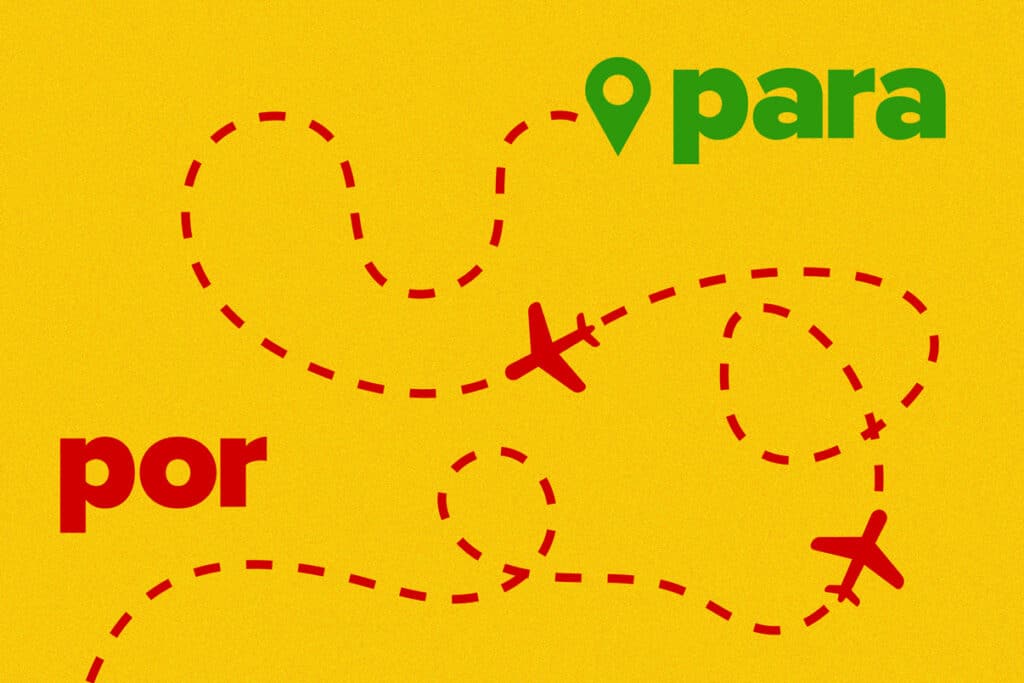
Knowing the difference between por
and para
can be tricky for most Spanish learners. Both can mean “for,” but they’re used in different situations.
Por is used for reasons, communication, travel, how long something goes on, transactions, substitutes and favors. Para is used when talking about recipients, destinations, goals, opinions and deadlines.
Read on to learn all about when to use each word, plus expressions that contain one or the other.
Contents
Download:
This blog post is available as a convenient and portable PDF that you
can take anywhere.
Click here to get a copy. (Download)
Differences Between Por and Para
Spanish Expressions with Por
| Spanish Expressions with Por | Example Sentence |
|---|---|
| Por ahora (for now) |
Por ahora, todo está controlado. (Everything is under control for the time being.) |
| Por completo (completely, absolutely) |
Se le olvidó por completo. (He completely forgot about it.) |
| Por ejemplo (for example) |
Juan y Pedro, por ejemplo. (Juan and Pedro, for example.) |
| Por favor (please) |
Ayúdame, por favor. (Help me, please.) |
| Por fin (finally, at last) |
¡Has vuelto! ¡Por fin! (You are back! At last!) |
| Por lo menos (at least) |
Necesito tres por lo menos. (I need three at least.) |
| Por lo visto (apparently) |
Por lo visto, él le ha sido infiel. (Apparently, he has cheated on her.) |
| Por si acaso (just in case) |
Vamos a volver por si acaso. (Let’s go back, just in case.) |
| Por supuesto (sure, of course) |
¡Por supuesto que no lo haré! (Of course I will not do it!) |
| ¿Por qué? Porque… (Why? because…) |
¿Por qué lloras? Porque estoy triste. (Why are you crying? Because I am sad.) |
| Gracias por (thanks for) |
Gracias por todo, mamá. (Thanks for everything, mum.) |
Spanish Expressions with Para
| Spanish Expressions with Para | Example Sentence |
|---|---|
| Para colmo (to top it all) |
Llegó tarde y, para colmo, no pidió disculpas. (He arrived late and, to top it all, he did not apologize.) |
| Para empezar (for starters) |
Para empezar, vamos a llamar a papá. (For starters, let’s call dad.) |
| Para entonces (by then) |
Ya había muerto para entonces. (He was dead by then.) |
| Para nada (not…at all) |
No me gusta para nada. (I do not like it at all.) |
| Para otra vez (for another time, for another day) |
Dejémoslo para otra vez. (Let’s leave it for another time.) |
| Para que / para qué (so that, in order to / what for) |
Lo hice para que vinieras. (I did it so that you would come.) |
| Para siempre (forever) |
Quiero estar contigo para siempre. (I want to be with you forever.) |
| Para variar (as usual, just for a change) |
Has vuelto a mentir, para variar. (You have lied again, just for a change.) |
| Estar para (to be about to) |
Estaba para salir cuando llamaste. (I was about to go out when you called.) |
Para mí vs. Por mí
Para mí
and por mí
are a special case because they not only have a difference in meaning, but they themselves also change meanings depending on where you put them in a sentence.
| Para mí | Por mí |
|---|---|
| At the beginning of a sentence, para mí means “in my opinion.”
Para mí, ese niño es muy inteligente. |
At the beginning of a sentence, por mí means “as far as I am concerned” or “as for me,” adding a sense of indifference.
Por mí como si no vuelve. |
| At the end of a sentence, para mí changes its meaning to “for me” (in contexts when we receive something).
Este regalo es para mí. |
At the end of a sentence, por mí means “instead of me,” “in my place” or “for me” (with the meaning of “for my sake”).
Irá de compras por mí. |
¿Para qué? vs. ¿Por qué?
Para qué and por qué are not as changeable as para mí and por mí, but they also have a difference in meaning.
We use para qué
when we want to ask for what purpose something was done:
On the other hand, ¿por qué?
(not to be confused with the other porques) means “Why?” or “For what reason?”
You may think that their meanings are too close or even related, since asking for a reason and asking for a purpose are definitely connected. However, there are situations where it’s obvious which one to use—like when you append no
at the end.
¿Por qué no? vs. ¿Para qué no?
¿Por qué no?
is used to ask for the reason “why not”:
¿Para qué no?
is a question that follows a negative statement or command. For example:
No uses eso para comer.
(Don’t use that for eating.)
¿Para qué no debo usarlo? No te he oído.
(What shouldn’t I use it for? I didn’t hear you.)
Where to Practice Por Versus Para
SpanishDict

This 40-question por versus para quiz will help you assess your knowledge in no time.
Every time you answer a question, you get instant feedback and a grammar explanation.
They even have a quick refresher on por and para at the end!
CliffsNotes

That’s right—this famous homework aid site has a quiz designed to test your knowledge of the differences between por and para.
Once you’re done with the quiz, you’ll get a quick preview of all the answers you got right and wrong at the end. The only point against this site is that it doesn’t explain why the answers are the way they are. You’ll have to analyze the reasons behind the correct answers on your own.
FluentU

FluentU takes real-world videos—like music videos, movie trailers, news and inspiring talks—and turns them into personalized language learning lessons.
Other sites use scripted content. FluentU uses a natural approach that helps you ease into the Spanish language and culture over time. You’ll learn Spanish as it’s actually spoken by real people.
FluentU has a wide variety of videos topics, as you can see here:

FluentU brings native videos within reach with interactive transcripts. You can tap on any word to look it up instantly. Every definition has examples that have been written to help you understand how the word is used.
Plus, if you see an interesting word you don’t know, you can add it to a vocab list.

Review a complete interactive transcript under the Dialogue tab, and find words and phrases listed under Vocab.

Learn all the vocabulary in any video with FluentU’s robust learning engine. Swipe left or right to see more examples of the word you’re on.

The best part is that FluentU keeps track of the vocabulary that you’re learning, and gives you extra practice with difficult words. It’ll even remind you when it’s time to review what you’ve learned. Every learner has a truly personalized experience, even if they’re studying with the same video.
Start using the FluentU website on your computer or tablet or, better yet, download the FluentU app from the iTunes or Google Play store. Click here to take advantage of our current sale! (Expires at the end of this month.)
Here are some additional tips for practicing por versus para:
- Do exercises and take quizzes. This will help you apply the words and remember them better.
- Write down lots of por and para sentences. This will help you start seeing patterns and expressions that repeat themselves so you learn faster.
- Create your own flashcards. This way, your por and para sentences will be with you all the time.
- Read a lot. Context is everything, and reading will give you plenty of real Spanish to gorge on.
- Listen to Spanish podcasts. Listening to podcasts will allow you to hear these prepositions used in natural speech.
- Watch Spanish movies, TV series and YouTube videos. Watching any kind of video material with native Spanish in it has similar benefits as listening to podcasts.
If you’re more of a visual learner, here’s a video on por versus para:
Now you know a little more about how to tell the difference between por and para.
Keep practicing, and soon it will be easier to use them correctly!


![Por Versus Para: Your Ultimate Guide to Knowing the Difference [Audio Included]](/wp-content/uploads/2024/03/illustration-of-por-with-dotted-travel-line-and-para-with-destination-marker-768x512.jpg)
